Delineation of Productive Zones in Eastern China Based on Multiple Soil Properties
Abstract
:1. Introduction
2. Materials and Methods
2.1. Study Area
2.2. Soil-Sampling Site Selection and Collection
2.3. Descriptive Statistics
2.4. Geostatistical Analysis
2.5. Principal Component Analysis
2.6. Fuzzy Cluster Algorithm
3. Results
3.1. Descriptive Statistics and Correlation among Soil Properties
3.2. Geostatistical Analysis
3.3. Principal Component Analysis
3.4. Delineation and Evaluation of the Management Zones
4. Discussion
5. Conclusions
Author Contributions
Funding
Data Availability Statement
Conflicts of Interest
References
- Thapa, G.B.; Yila, O.M. Farmers’ land management practices and status of agricultural land in the Jos Plateau, Nigeria. Land Degrad. Dev. 2010, 23, 263–277. [Google Scholar] [CrossRef]
- Janssen, B.H.; de Willigen, P. Ideal and saturated soil fertility as bench marks in nutrient management—1. Outline of the framework. Agric. Ecosyst. Environ. 2006, 116, 132–146. [Google Scholar] [CrossRef]
- Brejda, J.J.; Moorman, T.B.; Smith, J.L.; Karlen, D.L.; Allan, D.L.; Dao, T.H. Distribution and variability of surface soil properties at a regional scale. Soil Sci. Soc. Am. J. 2000, 64, 974–982. [Google Scholar] [CrossRef]
- Almasri, M.N.; Kaluarachchi, J.J. Assessment and management of long-term nitrate pollution of ground water in agriculture-dominated watersheds. J. Hydrol. 2004, 295, 225–245. [Google Scholar] [CrossRef]
- Ferguson, R.B.; Hergert, G.W.; Schepers, J.S.; Gotway, C.A.; Cahoon, J.E.; Peterson, T.A. Site-Specific Nitrogen Management of Irrigated Maize. Soil Sci. Soc. Am. J. 2002, 66, 544–553. [Google Scholar]
- Shashikumar, B.N.; Kumar, S.; George, K.J.; Singh, A.K. Soil variability mapping and delineation of site-specific management zones using fuzzy clustering analysis in a Mid-Himalayan Watershed, India. Environ. Dev. Sustain. 2023, 25, 8539–8559. [Google Scholar] [CrossRef]
- Daya, A.A.; Bejari, H. A comparative study between simple kriging and ordinary kriging for estimating and modeling the Cu concentration in Chehlkureh deposit, SE Iran. Arab. J. Geosci. 2014, 8, 6003–6020. [Google Scholar] [CrossRef]
- Mueller, T.G.; Hartsock, N.J.; Stombaugh, T.S.; Shearer, S.A.; Cornelius, P.L.; Barnhisel, R.I. Soil Electrical Conductivity Map Variability in Limestone Soils Overlain by Loess. Agron. J. 2003, 95, 496–507. [Google Scholar] [CrossRef]
- Fu, W.; Tunney, H.; Zhang, C. Spatial variation of soil nutrients in a dairy farm and its implications for site-specific fertilizer application. Soil Tillage Res. 2010, 106, 185–193. [Google Scholar] [CrossRef]
- Shukla, A.K.; Sinha, N.K.; Tiwari, P.K.; Prakash, C.; Behera, S.K.; Lenka, N.K.; Singh, V.K.; Dwivedi, B.S.; Majumdar, K.; Kumar, A.; et al. Spatial Distribution and Management Zones for Sulphur and Micronutrients in Shiwalik Himalayan Region of India. Land Degrad. Dev. 2017, 28, 959–969. [Google Scholar] [CrossRef]
- Brevik, E.C.; Calzolari, C.; Miller, B.A.; Pereira, P.; Kabala, C.; Baumgarten, A.; Jordán, A. Soil mapping, classification, and pedologic modeling: History and future directions. Geoderma 2016, 264, 256–274. [Google Scholar] [CrossRef]
- Li, Y.; Shi, Z.; Li, F.; Li, H.-Y. Delineation of site-specific management zones using fuzzy clustering analysis in a coastal saline land. Comput. Electron. Agric. 2007, 56, 174–186. [Google Scholar] [CrossRef]
- Fridgen, J.J.; Kitchen, N.R.; Sudduth, K.A.; Drummond, S.T.; Wiebold, W.J.; Fraisse, C.W. Management Zone Analyst (MZA): Software for subfield management zone delineation. Agron. J. 2004, 96, 100–108. [Google Scholar] [CrossRef]
- Brock, A.; Brouder, S.M.; Blumhoff, G.; Hofmann, B.S. Defining yield-based management zones for corn-soybean rotations. Agron. J. 2005, 97, 1115–1128. [Google Scholar] [CrossRef]
- Tripathi, R.; Nayak, A.K.; Shahid, M.; Lal, B.; Gautam, P.; Raja, R.; Mohanty, S.; Kumar, A.; Panda, B.B.; Sahoo, R.N. Delineation of soil management zones for a rice cultivated area in eastern India using fuzzy clustering. Catena 2015, 133, 128–136. [Google Scholar] [CrossRef]
- Kumar, P.; Sharma, M.; Butail, N.P.; Shukla, A.K.; Kumar, P. Spatial variability of soil properties and delineation of management zones for Suketi basin, Himachal Himalaya, India. Environ. Dev. Sustain. 2023, 1–26. [Google Scholar] [CrossRef]
- Kumar, P.; Kumar, P.; Sharma, M.; Shukla, A.K.; Butail, N.P. Spatial variability of soil nutrients in apple orchards and agricultural areas in Kinnaur region of cold desert, Trans-Himalaya, India. Environ. Monit. Assess. 2022, 194, 290. [Google Scholar] [CrossRef]
- Behera, S.K.; Mathur, R.K.; Shukla, A.K.; Suresh, K.; Prakash, C. Spatial variability of soil properties and delineation of soil management zones of oil palm plantations grown in a hot and humid tropical region of southern India. Catena 2018, 165, 251–259. [Google Scholar] [CrossRef]
- Jena, R.K.; Bandyopadhyay, S.; Pradhan, U.K.; Moharana, P.C.; Kumar, N.; Sharma, G.K.; Roy, P.D.; Ghosh, D.; Ray, P.; Padua, S.; et al. Geospatial Modelling for Delineation of Crop Management Zones Using Local Terrain Attributes and Soil Properties. Remote Sens. 2022, 14, 2101. [Google Scholar] [CrossRef]
- Miller, B.A.; Koszinski, S.; Hierold, W.; Rogasik, H.; Schröder, B.; Van Oost, K.; Wehrhan, M.; Sommer, M. Towards mapping soil carbon landscapes: Issues of sampling scale and transferability. Soil Tillage Res. 2016, 156, 194–208. [Google Scholar] [CrossRef]
- Jia, X.; Li, X.; Li, Y. Fractal dimension of soil particle size distribution during the process of vegetation restoration in arid sand dune area. Geogr. Res. 2007, 26, 518–525. [Google Scholar]
- Jackson, M.L. Soil Chemical Analysis: Advanced Course; UW-Madison Libraries Parallel Press: Madison, WI, USA, 2005. [Google Scholar]
- Bao, S.D. Agricultural and Chemistry Analysis of Soil, 3rd ed.; Agriculture Press: Beijing, China, 2005; pp. 25–238. [Google Scholar]
- Liu, G.; Yang, J.; Zhang, M. Spatial variability and distribution pattern of soil nutrients in Bohai coastal area. Acta Pedol. Sin. 2014, 51, 944–952. [Google Scholar]
- Oldoni, H.; Silva Terra, V.S.; Timm, L.C.; Júnior, C.R.; Monteiro, A.B. Delineation of management zones in a peach orchard using multivariate and geostatistical analyses. Soil Tillage Res. 2019, 191, 1–10. [Google Scholar] [CrossRef]
- Jiang, H.L.; Liu, G.S.; Liu, S.D.; Li, E.H.; Wang, R.; Yang, Y.F.; Hu, H.C. Delineation of site-specific management zones based on soil properties for a hillside field in central China. Arch. Agron. Soil Sci. 2012, 58, 1075–1090. [Google Scholar] [CrossRef]
- RM, L.; JV, S. Classification as a first step in the interpretation of temporal and spatial variation of crop yield. Ann. Appl. Biol. 1997, 130, 111–121. [Google Scholar]
- Reyniers, M.; Maertens, K.; Vrindts, E.; De Baerdemaeker, J. Yield variability related to landscape properties of a loamy soil in central Belgium. Soil Tillage Res. 2006, 88, 262–273. [Google Scholar] [CrossRef]
- Zhang, X.Y.; Sui, Y.Y.; Zhang, X.D.; Meng, K.; Herbert, S.J. Spatial variability of nutrient properties in black soil of northeast China. Pedosphere 2007, 17, 19–29. [Google Scholar] [CrossRef]
- Wang, X.-Z.; Liu, G.-S.; Hu, H.-C.; Wang, Z.-H.; Liu, Q.-H.; Liu, X.-F.; Hao, W.-H.; Li, Y.-T. Determination of management zones for a tobacco field based on soil fertility. Comput. Electron. Agric. 2009, 65, 168–175. [Google Scholar]
- Yang, C.H.; Crowley, D.E. Rhizosphere microbial community structure in relation to root location and plant iron nutritional status. Appl. Environ. Microbiol. 2000, 66, 345–351. [Google Scholar] [CrossRef]
- Wang, X.J.; Tang, C.X. The role of rhizosphere pH in regulating the rhizosphere priming effect and implications for the availability of soil-derived nitrogen to plants. Ann. Bot. 2018, 121, 143–151. [Google Scholar] [CrossRef]
- Hinsinger, P. Bioavailability of soil inorganic P in the rhizosphere as affected by root-induced chemical changes: A review. Plant Soil 2001, 237, 173–195. [Google Scholar] [CrossRef]
- Gudmundsson, T.; Björnsson, H.; Thorvaldsson, G. Organic carbon accumulation and pH changes in an Andic Gleysol under a long-term fertilizer experiment in Iceland. Catena 2004, 56, 213–224. [Google Scholar] [CrossRef]
- Hu, S.; Chapin, F.S.; Firestone, M.K.; Field, C.B.; Chiariello, N.R. Nitrogen limitation of microbial decomposition in a grassland under elevated CO2. Nature 2001, 409, 188–191. [Google Scholar] [CrossRef] [PubMed]
- Schlesinger, W.H.; Lichter, J. Limited carbon storage in soil and litter of experimental forest plots under increased atmospheric CO2. Nature 2001, 411, 466–469. [Google Scholar] [CrossRef]
- Oliver, M.A.; Webster, R. A tutorial guide to geostatistics: Computing and modelling variograms and kriging. Catena 2014, 113, 56–69. [Google Scholar] [CrossRef]
- Gao, Z.Q.; Fu, W.J.; Zhang, M.J.; Zhao, K.L.; Tunney, H.; Guan, Y.D. Potentially hazardous metals contamination in soil-rice system and it’s spatial variation in Shengzhou City, China. J. Geochem. Explor. 2016, 167, 62–69. [Google Scholar] [CrossRef]
- Lopez-Granados, F.; Jurado-Exposito, M.; Atenciano, S.; Garcia-Ferrer, A.; de la Orden, M.S.; Garcia-Torres, L. Spatial variability of agricultural soil parameters in southern Spain. Plant Soil 2002, 246, 97–105. [Google Scholar] [CrossRef]
- Kerry, R.; Oliver, M.A. Average variograms to guide soil sampling. Int. J. Appl. Earth Obs. Geoinf. 2004, 5, 307–325. [Google Scholar] [CrossRef]
- Chen, X.Q.; Li, T.; Lu, D.J.; Cheng, L.; Zhou, J.M.; Wang, H.Y. Estimation of soil available potassium in Chinese agricultural fields using a modified sodium tetraphenyl boron method. Land Degrad. Dev. 2020, 31, 1737–1748. [Google Scholar] [CrossRef]
- He, P.; Yang, L.P.; Xu, X.P.; Zhao, S.C.; Chen, F.; Li, S.T.; Tu, S.H.; Jin, J.Y.; Johnston, A.M. Temporal and spatial variation of soil available potassium in China (1990–2012). Field Crops Res. 2015, 173, 49–56. [Google Scholar] [CrossRef]
- Yao, R.-J.; Yang, J.-S.; Zhang, T.-J.; Gao, P.; Wang, X.-P.; Hong, L.-Z.; Wang, M.-W. Determination of site-specific management zones using soil physico-chemical properties and crop yields in coastal reclaimed farmland. Geoderma 2014, 232–234, 381–393. [Google Scholar] [CrossRef]
- MatÍAs, L.; Castro, J.; Zamora, R. Soil-nutrient availability under a global-change scenario in a Mediterranean mountain ecosystem. Glob. Chang. Biol. 2011, 17, 1646–1657. [Google Scholar] [CrossRef]
- Delgado-Baquerizo, M.; Maestre, F.T.; Gallardo, A.; Bowker, M.A.; Wallenstein, M.D.; Quero, J.L.; Ochoa, V.; Gozalo, B.; Garcia-Gomez, M.; Soliveres, S.; et al. Decoupling of soil nutrient cycles as a function of aridity in global drylands. Nature 2013, 502, 672–676. [Google Scholar] [CrossRef] [PubMed]
- Jianping, L.; Aizhen, D.; Xiaomin, Z.; Yefeng, J.; Yi, H.; Yu, X. Variation characteristics of soil nutrients of cultivated land in different elevation fields in typical hilly areas of southern mountains. Trans. Chin. Soc. Agric. Mach. 2019, 50, 300–309. [Google Scholar]
- Ondrasek, G.; Bakic Begic, H.; Zovko, M.; Filipovic, L.; Merino-Gergichevich, C.; Savic, R.; Rengel, Z. Biogeochemistry of soil organic matter in agroecosystems & environmental implications. Sci Total Environ. 2019, 658, 1559–1573. [Google Scholar]
- Six, J.; Bossuyt, H.; Degryze, S.; Denef, K. A history of research on the link between (micro)aggregates, soil biota, and soil organic matter dynamics. Soil Tillage Res. 2004, 79, 7–31. [Google Scholar] [CrossRef]
- Plante, A.F.; Fernández, J.M.; Haddix, M.L.; Steinweg, J.M.; Conant, R.T. Biological, chemical and thermal indices of soil organic matter stability in four grassland soils. Soil Biol. Biochem. 2011, 43, 1051–1058. [Google Scholar] [CrossRef]
- Powlson, D.S.; Riche, A.B.; Coleman, K.; Glendining, M.J.; Whitmore, A.P. Carbon sequestration in European soils through straw incorporation: Limitations and alternatives. Waste Manag. 2008, 28, 741–746. [Google Scholar] [CrossRef]
- Li, T.; Zhang, Y.; Bei, S.; Li, X.; Reinsch, S.; Zhang, H.; Zhang, J. Contrasting impacts of manure and inorganic fertilizer applications for nine years on soil organic carbon and its labile fractions in bulk soil and soil aggregates. Catena 2020, 194, 104739. [Google Scholar] [CrossRef]
- Han, T.F.; Liu, K.L.; Huang, J.; Ma, C.B.; Zheng, L.; Wang, H.Y.; Qu, X.L.; Ren, Y.; Yu, Z.K.; Zhang, H.M. Spatio-temporal evolution of soil pH and its driving factors in the main Chinese farmland during past 30 years. J. Plant Nutr. Fertil. 2020, 26, 2137–2149. [Google Scholar]
- Brown, T.T.; Koenig, R.T.; Huggins, D.R.; Harsh, J.B.; Rossi, R.E. Lime Effects on Soil Acidity, Crop Yield, and Aluminum Chemistry in Direct-Seeded Cropping Systems. Soil Sci. Soc. Am. J. 2008, 72, 634–640. [Google Scholar] [CrossRef]
- Lupwayi, N.Z.; Benke, M.B.; Hao, X.; O’Donovan, J.T.; Clayton, G.W. Relating Crop Productivity to Soil Microbial Properties in Acid Soil Treated with Cattle Manure. Agron. J. 2014, 106, 612–621. [Google Scholar] [CrossRef]
- Wan, W.; Tan, J.; Wang, Y.; Qin, Y.; He, H.; Wu, H.; Zuo, W.; He, D. Responses of the rhizosphere bacterial community in acidic crop soil to pH: Changes in diversity, composition, interaction, and function. Sci. Total Environ. 2020, 700, 134418. [Google Scholar] [CrossRef] [PubMed]
- Hao, T.; Zhu, Q.; Zeng, M.; Shen, J.; Shi, X.; Liu, X.; Zhang, F.; de Vries, W. Quantification of the contribution of nitrogen fertilization and crop harvesting to soil acidification in a wheat-maize double cropping system. Plant Soil 2018, 434, 167–184. [Google Scholar] [CrossRef]
- Zhu, Y.; Luo, J. Potassium status and contents of K-bearing minerals of some soils in Southern China. Acta Pedol. Sin. 1994, 31, 430–438. [Google Scholar]
- Xiong, W.; Lin, E.; Ju, H.; Xu, Y. Climate change and critical thresholds in China’s food security. Clim. Chang. 2007, 81, 205–221. [Google Scholar] [CrossRef]
- Xiong, W.; Matthews, R.; Holman, I.; Lin, E.; Xu, Y. Modelling China’s potential maize production at regional scale under climate change. Clim. Chang. 2007, 85, 433–451. [Google Scholar] [CrossRef]
- Yao, F.; Xu, Y.; Lin, E.; Yokozawa, M.; Zhang, J. Assessing the impacts of climate change on rice yields in the main rice areas of China. Clim. Chang. 2007, 80, 395–409. [Google Scholar] [CrossRef]
- Rosenzweig, C.; Strzepek, K.M.; Major, D.C.; Iglesias, A.; Yates, D.N.; McCluskey, A.; Hillel, D. Water resources for agriculture in a changing climate: International case studies. Glob. Environ. Chang. 2004, 14, 345–360. [Google Scholar] [CrossRef]
- Olfs, H.W.; Blankenau, K.; Brentrup, F.; Jasper, J.; Link, A.; Lammel, J. Soil-and plant-based nitrogen-fertilizer recommendations in arable farming. J. Plant Nutr. Soil Sci. 2005, 168, 414–431. [Google Scholar] [CrossRef]
- Chen, Y.-E.; Su, Y.-Q.; Zhang, C.-M.; Ma, J.; Mao, H.-T.; Yang, Z.-H.; Yuan, M.; Zhang, Z.-W.; Yuan, S.; Zhang, H.-Y. Comparison of Photosynthetic Characteristics and Antioxidant Systems in Different Wheat Strains. J. Plant Growth Regul. 2017, 37, 347–359. [Google Scholar] [CrossRef]
- Zhang, M.; Ma, D.; Ma, G.; Wang, C.; Xie, X.; Kang, G. Responses of glutamine synthetase activity and gene expression to nitrogen levels in winter wheat cultivars with different grain protein content. J. Cereal Sci. 2017, 74, 187–193. [Google Scholar] [CrossRef]
- Gallardo, A. Spatial Variability of Soil Properties in a Floodplain Forest in Northwest Spain. Ecosystems 2003, 6, 564–576. [Google Scholar] [CrossRef]
- Riedell, W.E.; Pikul, J.L.; Jaradat, A.A.; Schumacher, T.E. Crop Rotation and Nitrogen Input Effects on Soil Fertility, Maize Mineral Nutrition, Yield, and Seed Composition. Agron. J. 2009, 101, 870–879. [Google Scholar] [CrossRef]
- Guo, Q.H.; Li, W.K.; Yu, H.; Alvarez, O. Effects of Topographic Variability and Lidar Sampling Density on Several DEM Interpolation Methods. Photogramm. Eng. Remote Sens. 2010, 76, 701–712. [Google Scholar] [CrossRef]
- Ye, H.; Huang, W.; Huang, S.; Huang, Y.; Zhang, S.; Dong, Y.; Chen, P. Effects of different sampling densities on geographically weighted regression kriging for predicting soil organic carbon. Spat. Stat. 2017, 20, 76–91. [Google Scholar] [CrossRef]
- Orton, T.G.; Lark, R.M. Accounting for the uncertainty in the local mean in spatial prediction by Bayesian Maximum Entropy. Stoch. Environ. Res. Risk Assess. 2006, 21, 773–784. [Google Scholar] [CrossRef]
- Lee, S.-J.; Balling, R.; Gober, P. Bayesian Maximum Entropy Mapping and the Soft Data Problem in Urban Climate Research. Ann. Assoc. Am. Geogr. 2008, 98, 309–322. [Google Scholar] [CrossRef]
- Adhikari, K.; Mishra, U.; Owens, P.R.; Libohova, Z.; Wills, S.A.; Riley, W.J.; Hoffman, F.M.; Smith, D.R. Importance and strength of environmental controllers of soil organic carbon changes with scale. Geoderma 2020, 375, 114472. [Google Scholar] [CrossRef]
- Miller, B.A.; Koszinski, S.; Wehrhan, M.; Sommer, M. Impact of multi-scale predictor selection for modeling soil properties. Geoderma 2015, 239–240, 97–106. [Google Scholar] [CrossRef]
- Qi-yong, Y.; Zhong-cheng, J.; Wen-jun, L.; Hui, L. Prediction of soil organic matter in peak-cluster depression region using kriging and terrain indices. Soil Tillage Res. 2014, 144, 126–132. [Google Scholar] [CrossRef]
- Betzek, N.M.; de Souza, E.G.; Bazzi, C.L.; Schenatto, K.; Gavioli, A. Rectification methods for optimization of management zones. Comput. Electron. Agric. 2018, 146, 1–11. [Google Scholar] [CrossRef]

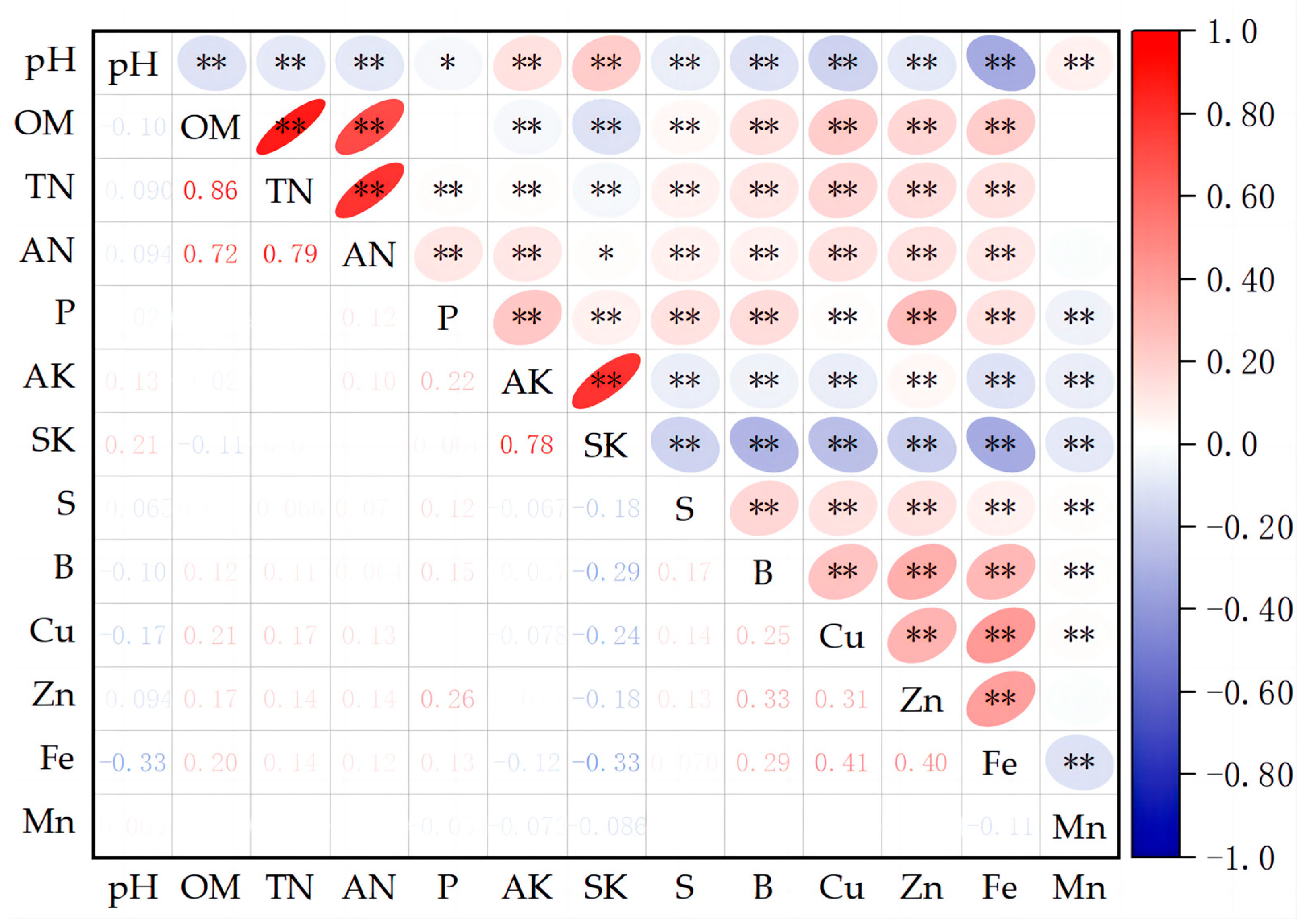
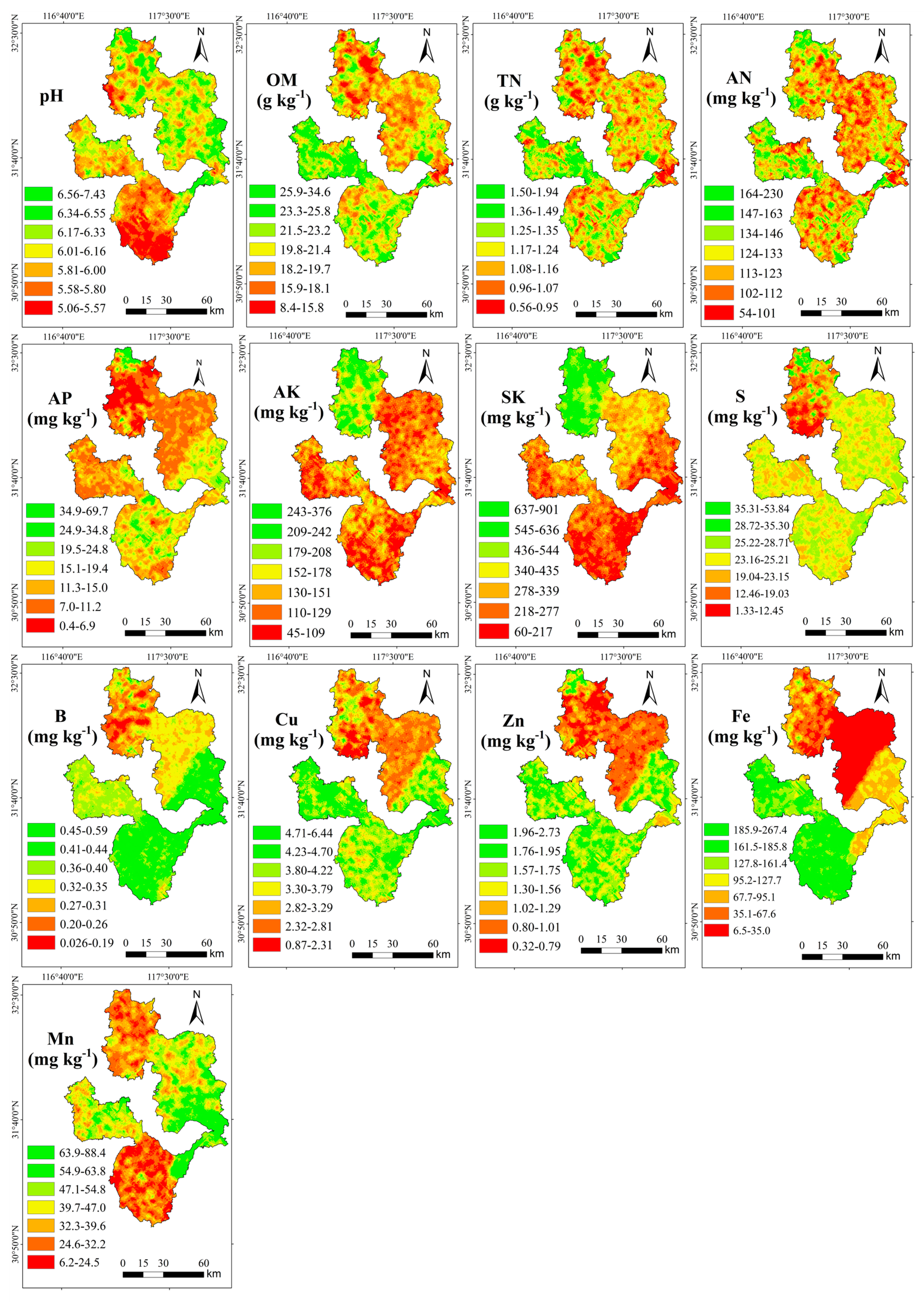
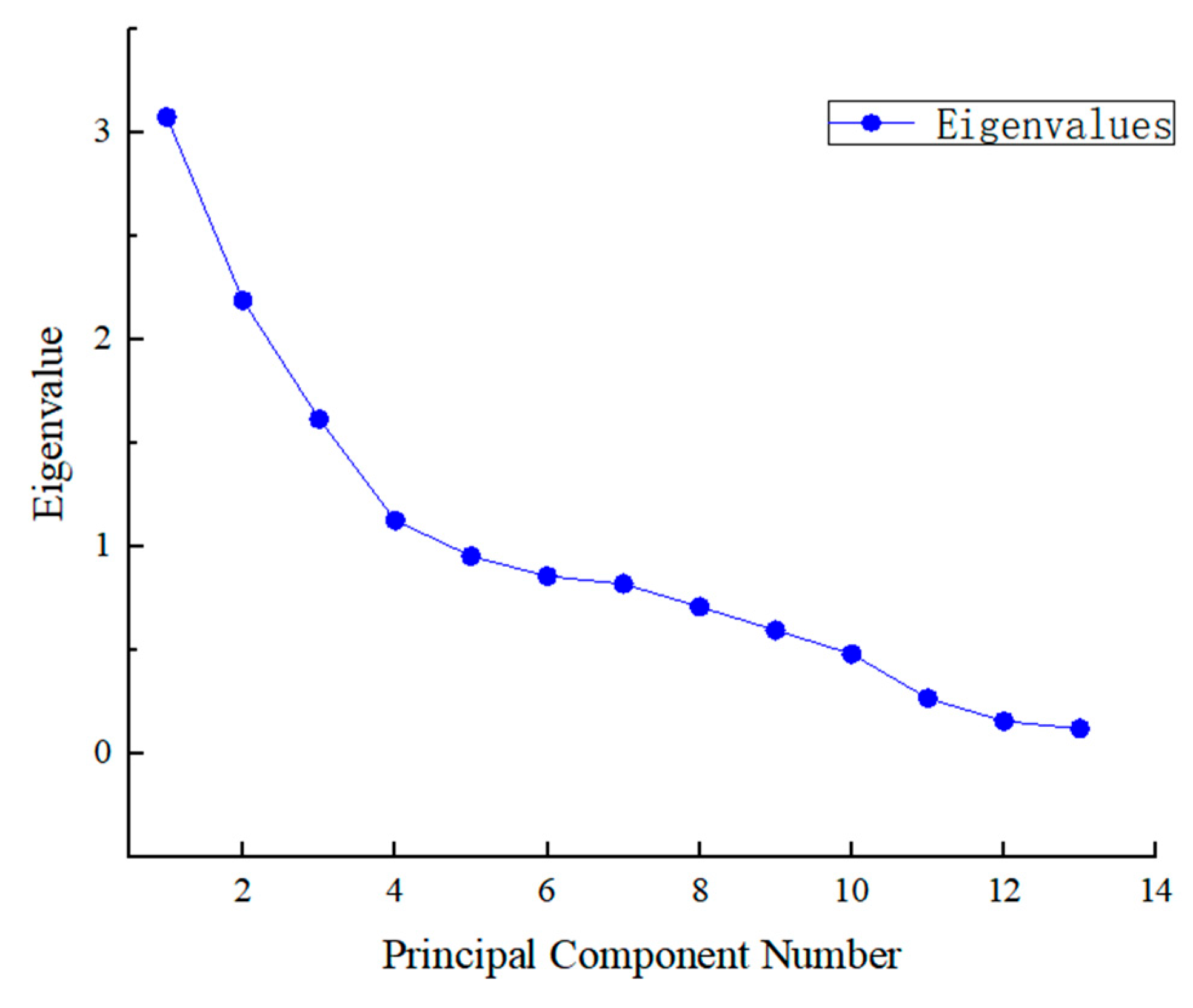


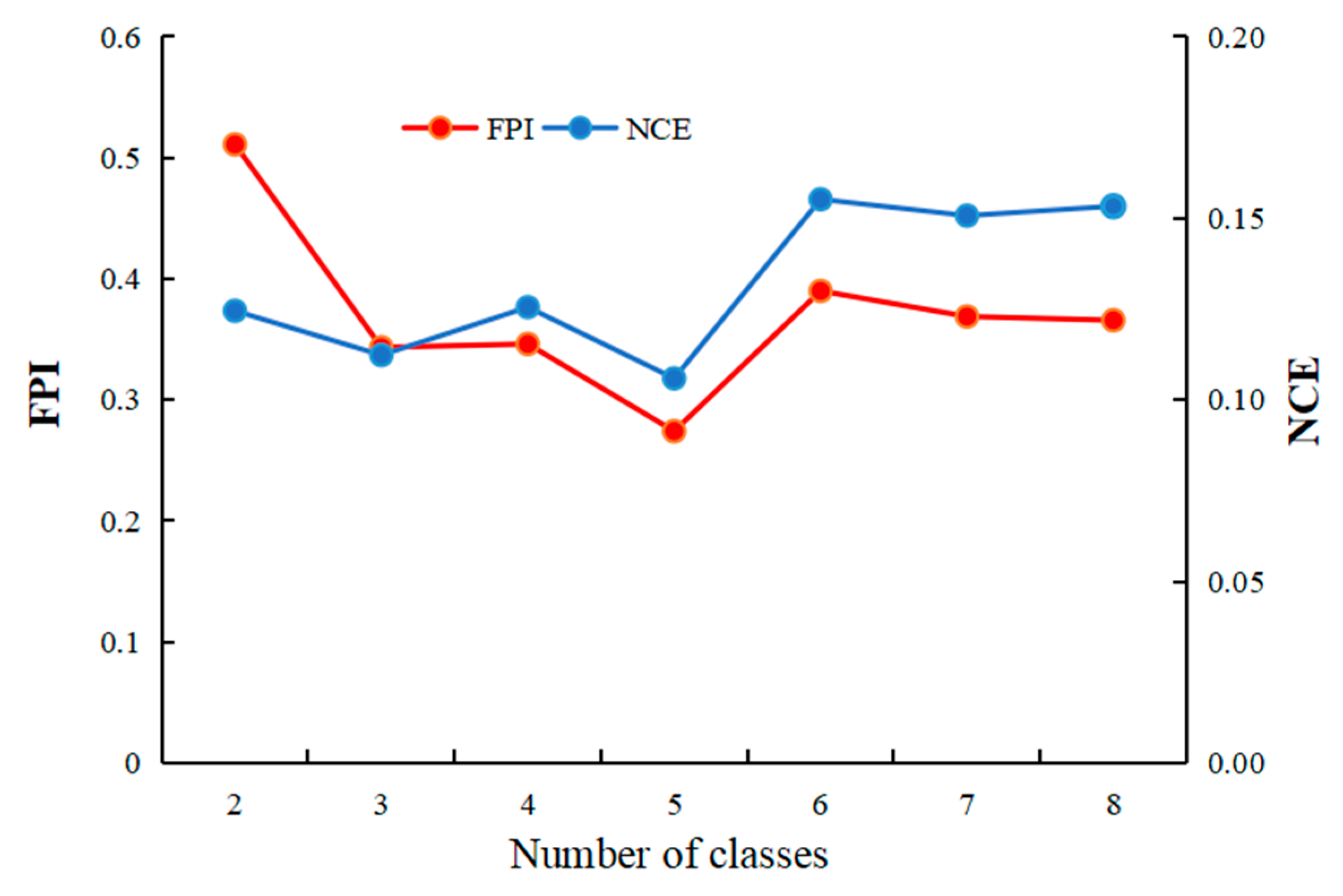
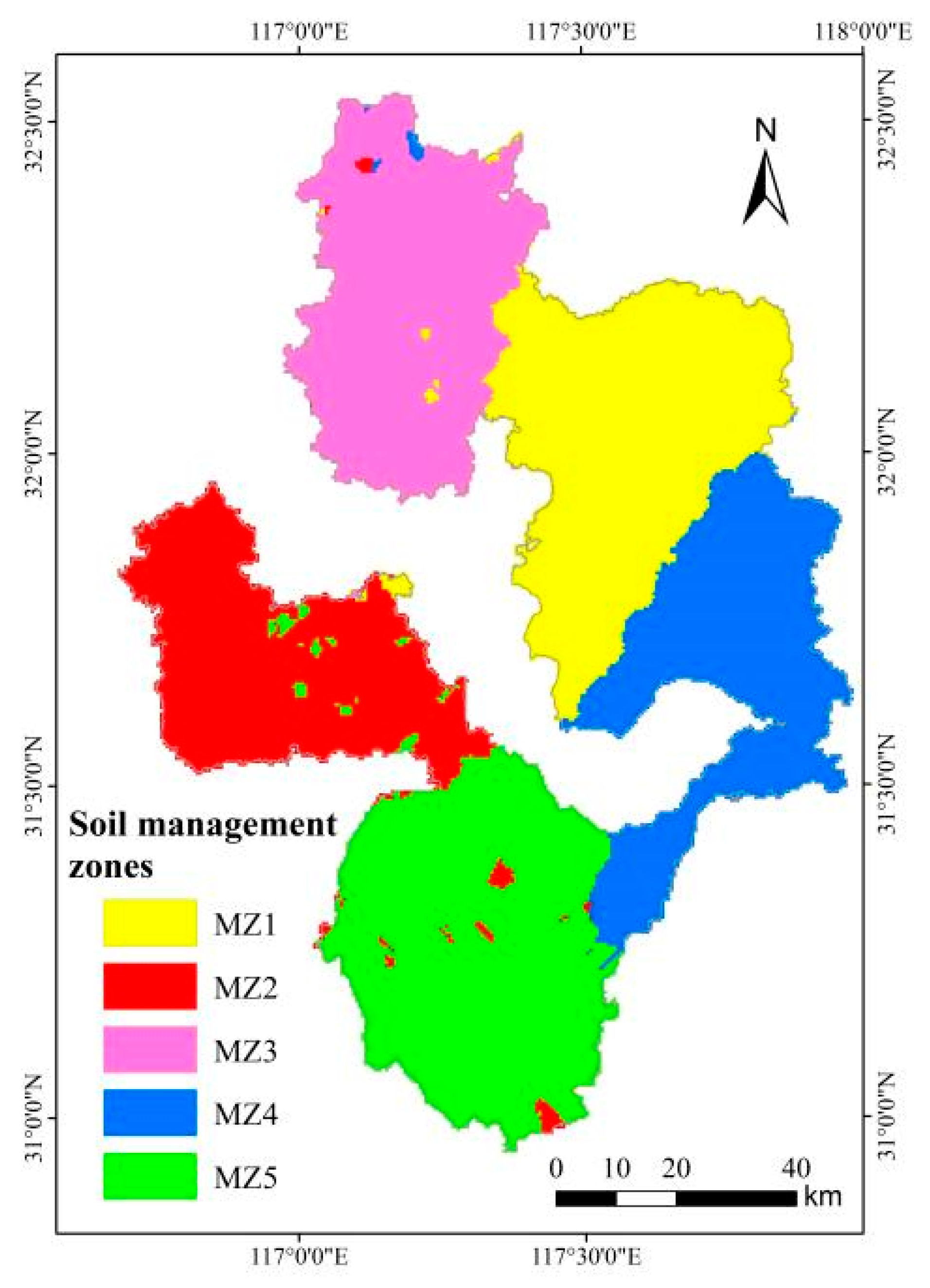
| Soil Properties | Minimum | Maximum | Mean | SD | CV (%) | Distribution Pattern | Skewness | Kurtosis |
|---|---|---|---|---|---|---|---|---|
| pH | 4.23 | 8.76 | 6.06 | 0.74 | 12.2 | Lognormality | 0.06 | −0.50 |
| OM (g·kg−1) | 1.3 | 48.7 | 20.6 | 7.6 | 36.8 | Normality | 0.38 | −0.02 |
| TN (g·kg−1) | 0.16 | 2.71 | 1.19 | 0.41 | 34.5 | Normality | 0.29 | −0.06 |
| AN (mg·kg−1) | 7 | 309 | 124 | 49 | 39.8 | Normality | 0.59 | 0.27 |
| AP (mg·kg−1) | 0.2 | 148.9 | 18.3 | 18.3 | 100.5 | Lognormality | −1.00 | 2.34 |
| AK (mg·kg−1) | 22 | 594 | 146 | 77 | 53.0 | Lognormality | −0.24 | 0.08 |
| SK (mg·kg−1) | 34 | 1189 | 334 | 187 | 55.9 | Lognormality | −0.32 | −0.09 |
| S (mg·kg−1) | 0.05 | 148.93 | 24.55 | 13.50 | 55.0 | Normality | 1.02 | 5.51 |
| B (mg·kg−1) | 0.01 | 0.80 | 0.37 | 0.13 | 33.8 | Normality | 0.17 | 0.54 |
| Cu (mg·kg−1) | 0.02 | 9.17 | 3.56 | 1.42 | 40.0 | Normality | 0.47 | 0.14 |
| Zn (mg·kg−1) | 0.03 | 5.51 | 1.39 | 0.75 | 53.8 | Normality | 0.76 | 0.33 |
| Fe (mg·kg−1) | 0.2 | 361.5 | 102.0 | 81.2 | 79.6 | Normality | 0.54 | −0.79 |
| Mn (mg·kg−1) | 0.6 | 143.7 | 41.1 | 29.0 | 70.6 | Normality | 0.61 | −0.36 |
| Soil Properties | Model | Nugget | Sill | Nugget/Sill | Range (m) |
|---|---|---|---|---|---|
| pH | Spherical | 0.012 | 0.013 | 0.92 | 4464 |
| OM (g·kg−1) | Spherical | 50.524 | 52.806 | 0.96 | 2926 |
| TN (g·kg−1) | Exponential | 0.107 | 0.163 | 0.66 | 535 |
| AN (mg·kg−1) | Gaussian | 1187.227 | 2370.535 | 0.50 | 254 |
| AP (mg·kg−1) | Gaussian | 0.562 | 0.604 | 0.93 | 2027 |
| AK (mg·kg−1) | Exponential | 0.043 | 0.188 | 0.23 | 374 |
| SK (mg·kg−1) | Exponential | 0.027 | 0.198 | 0.14 | 458 |
| S (mg·kg−1) | J-Bessel | 56.802 | 77.953 | 0.73 | 102 |
| B (mg·kg−1) | J-Bessel | 0.009 | 0.011 | 0.82 | 52 |
| Cu (mg·kg−1) | Exponential | 0.6 | 1.613 | 0.37 | 399 |
| Zn (mg·kg−1) | J-Bessel | 0.325 | 0.374 | 0.87 | 49 |
| Fe (mg·kg−1) | Exponential | 1674.865 | 2585.963 | 0.65 | 49 |
| Mn (mg·kg−1) | Gaussian | 692.882 | 726.547 | 0.95 | 4225 |
| Principal Component | Eigenvalues | Component Loading (%) | Cumulative Loadings (%) |
|---|---|---|---|
| PC1 | 3.076 | 23.664 | 23.664 |
| PC2 | 2.191 | 16.853 | 40.517 |
| PC3 | 1.618 | 12.446 | 52.963 |
| PC4 | 1.128 | 8.680 | 61.643 |
| PC5 | 0.956 | 7.350 | 68.993 |
| PC6 | 0.860 | 6.615 | 75.608 |
| PC7 | 0.823 | 6.329 | 81.938 |
| PC8 | 0.711 | 5.469 | 87.407 |
| PC9 | 0.599 | 4.606 | 92.012 |
| PC10 | 0.484 | 3.723 | 95.735 |
| PC11 | 0.271 | 2.082 | 97.817 |
| PC12 | 0.160 | 1.230 | 99.047 |
| PC13 | 0.124 | 0.953 | 100.000 |
| Principal Component | pH | OM | TN | AN | AP | AK | SK | S | B | Cu | Zn | Fe | Mn |
|---|---|---|---|---|---|---|---|---|---|---|---|---|---|
| PC1 | −0.343 | 0.767 | 0.744 | 0.678 | 0.173 | −0.190 | −0.426 | 0.255 | 0.441 | 0.524 | 0.500 | 0.572 | 0.004 |
| PC2 | 0.259 | 0.454 | 0.539 | 0.570 | 0.073 | 0.637 | 0.714 | −0.183 | −0.318 | −0.267 | −0.194 | −0.368 | −0.060 |
| PC3 | −0.013 | −0.274 | −0.257 | −0.160 | 0.623 | 0.626 | 0.383 | 0.134 | 0.306 | 0.190 | 0.504 | 0.279 | −0.211 |
| PC4 | 0.499 | −0.001 | 0.020 | 0.020 | 0.174 | −0.022 | −0.082 | 0.443 | 0.257 | −0.038 | 0.114 | −0.336 | 0.672 |
| Management Zone | n | pH | OM | TN | AN | AP | AK | SK | S | B | Cu | Zn | Fe | Mn |
|---|---|---|---|---|---|---|---|---|---|---|---|---|---|---|
| MZ1 | 2238 | 6.21 a | 19.1 c | 1.16 c | 115 d | 12.3 d | 118 d | 328 b | 24.73 ab | 0.33 c | 2.77 e | 0.89 c | 20.0 e | 47.0 b |
| MZ2 | 1650 | 6.03 b | 23.6 a | 1.31 a | 137 a | 14.4 c | 130 c | 272 c | 24.31 b | 0.37 b | 4.36 a | 1.70 a | 164.1 b | 44.2 c |
| MZ3 | 1952 | 6.19 a | 18.7 d | 1.12 d | 129 b | 19.5 b | 207 a | 556 a | 20.78 c | 0.28 d | 2.92 d | 1.09 b | 64.7 d | 31.6 d |
| MZ4 | 1634 | 6.19 a | 21.1 b | 1.19 b | 126 b | 20.0 b | 137 b | 245 d | 25.16 a | 0.44 a | 4.06 b | 1.68 a | 91.9 c | 57.0 a |
| MZ5 | 2127 | 5.69 c | 21.0 b | 1.18 bc | 118 c | 21.3 a | 130 c | 239 d | 24.67 ab | 0.45 a | 3.98 c | 1.71 a | 182.4 a | 28.6 e |
Disclaimer/Publisher’s Note: The statements, opinions and data contained in all publications are solely those of the individual author(s) and contributor(s) and not of MDPI and/or the editor(s). MDPI and/or the editor(s) disclaim responsibility for any injury to people or property resulting from any ideas, methods, instructions or products referred to in the content. |
© 2023 by the authors. Licensee MDPI, Basel, Switzerland. This article is an open access article distributed under the terms and conditions of the Creative Commons Attribution (CC BY) license (https://creativecommons.org/licenses/by/4.0/).
Share and Cite
Tong, T.; Mei, S.; Cao, C.; Legesse, N.; Chang, J.; Ying, C.; Ma, Y.; Wang, Q. Delineation of Productive Zones in Eastern China Based on Multiple Soil Properties. Agronomy 2023, 13, 2869. https://doi.org/10.3390/agronomy13122869
Tong T, Mei S, Cao C, Legesse N, Chang J, Ying C, Ma Y, Wang Q. Delineation of Productive Zones in Eastern China Based on Multiple Soil Properties. Agronomy. 2023; 13(12):2869. https://doi.org/10.3390/agronomy13122869
Chicago/Turabian StyleTong, Tong, Shuai Mei, Chi Cao, Nebiyou Legesse, Junfeng Chang, Chunyang Ying, Youhua Ma, and Qingyun Wang. 2023. "Delineation of Productive Zones in Eastern China Based on Multiple Soil Properties" Agronomy 13, no. 12: 2869. https://doi.org/10.3390/agronomy13122869





